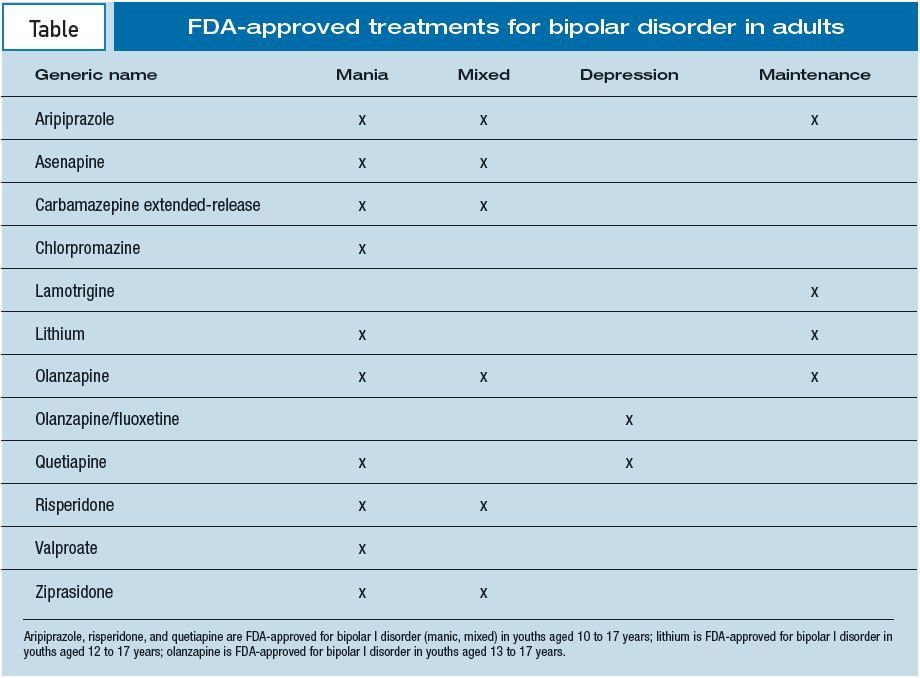Publication
Article
Psychiatric Times
New Drug Developments for Bipolar Mania
Author(s):
While challenges in treating mania persist, the future discovery of novel therapeutic agents will likely expand our understanding of this devastating illness and provide key insights into future drug development.
Table: FDA-approved Treatments for Bipolar Disorder in Adults


Bipolar disorder (BP) is a chronic, debilitating illness that affects 0.4% to 4% of the US population.1,2 The first nosological efforts describing BP appeared in the early 2nd century ad and culminated in Kraepelin’s eloquent description of its phenomenology in his 1921 textbook on manic-depressive insanity.3 Nevertheless, the course and underlying pathophysiology of BP remain elusive.
The disorder is frequently unrecognized, misdiagnosed, and not optimally managed. Moreover, no agent has been specifically developed on the basis of an understanding of the pathophysiology of the illness or mechanism of action of effective treatments.
The current gold standard treatment for BP is lithium, whose mood-stabilizing effects are believed to occur via distinct cellular signaling pathways/targets, such as glycogen synthase kinase 3 inhibition (considered to regulate cellular apoptosis), and other potential downstream cellular mechanisms. In addition to lithium, valproate, and carbamazepine, several atypical antipsychotics (including asenapine) are FDA-approved for the treatment of acute bipolar mania (Table).
While these drugs have certainly provided relief for many individuals with BP, significant issues with tolerability and efficacy remain. For instance, clinicians may find themselves in situations in which better-tolerated agents are less effective, and vice versa. In addition, balancing efficacy with adverse effects that affect adherence, such as sedation and weight gain, underscore the urgent need to develop novel and more effective treatments.
Recent clinical findings
Findings from a meta-analysis indicate that the following agents were more effective than placebo for mania: aripiprazole, asenapine, carbamazepine, cariprazine, haloperidol, lithium, olanzapine, paliperidone, quetiapine, risperidone, tamoxifen, valproate, and ziprasidone).4 Limited data suggest large effect sizes for carbamazepine, cariprazine, haloperidol, risperidone, and tamoxifen.
Another large meta-analysis evaluated the comparative efficacy of aripiprazole, asenapine, carbamazepine, valproate, gabapentin, haloperidol, lamotrigine, lithium, olanzapine, quetiapine, risperidone, topiramate, and ziprasidone at therapeutic doses for treatment of acute mania.5 The study concluded that antipsychotic drugs were significantly more effective than mood stabilizers; olanzapine, risperidone, and quetiapine were better tolerated than haloperidol. Risperidone, olanzapine, and haloperidol were particularly efficacious. Most of the trials were short (typically 3 weeks), and therefore caution is needed when extrapolating the results to clinical practice. It is also important to note that because of informed consent and general enrollment issues with manic patients, more severe cases were invariably excluded.
Because strong evidence exists for the use of lithium-and to a somewhat lesser extent, lamotrigine and valproate-as a maintenance treatment for BP, antipsychotics may be increasingly used to treat the acute manic phase of the disorder and mood stabilizers (particularly lithium) may be used for long-term treatment. Nivoli and colleagues6 reviewed the major guidelines for the treatment of manic/hypomanic and mixed episodes and found that all guidelines agreed that concurrent antidepressants should be stopped during a manic/mixed episode.
Recent drug developments in BP
Improved pharmacological strategies with pronounced and sustained effects would have an enormous impact on public health, particularly given the high mortality associated with BP. A variety of compounds are now being tested that offer mechanistically different approaches for the treatment of BP. Some of the drugs we will discuss target particular pathways specific to lithium, while others focus on more novel targets, such as N-methyl-D-aspartate (NMDA) and opiate receptors. Evidence also suggests that older agents used to treat other diseases can be “re-purposed” if they show promise in reducing manic activity.7 While the focus of these compounds is on the treatment of mania, some may also be beneficial during the depressed phase of the illness.
Tamoxifen. Tamoxifen is a protein kinase C (PKC) inhibitor and antiestrogenic drug that crosses the blood-brain barrier and is relatively well tolerated (up to 200 mg/d). Lithium is thought to regulate the PKC signaling cascade, and findings suggest that PKC activation enhances the release of dopamine, a neurotransmitter implicated in mania.8 A recent genome-wide association study also implicated diacylglycerol kinase eta (DGKH) in the pathogensis of BP; DGKH is a key protein in the lithium-sensitive phosphatidylinositol pathway and a precursor to PKC.9
A number of studies evaluated the effects of adjunctive tamoxifen treatment for mania, with encouraging results. The most recent of these was a double-blind, randomized, placebo-controlled, 6-week study (N = 40) that evaluated the efficacy and safety of tamoxifen with adjunctive lithium in the treatment of acute bipolar mania.10 Combined tamoxifen/lithium therapy was superior to lithium alone for rapidly reducing manic symptoms; results were apparent as early as day 7. In that study, all psychotropic medications except benzodiazepines were discontinued at least 48 hours before randomization.
Lorazepam (1 to 2 mg/d) was stopped after the initial 10 days and was not dispensed within 8 hours of the administration of the mania rating scale. The starting dosage of tamoxifen was 20 mg twice daily (40 mg/d). Daily doses were subsequently increased by 10 mg to achieve 80 mg/d in twice-daily divided doses. This dosage of tamoxifen was well tolerated, and no clinically significant adverse effects except fatigue were observed. Despite these clinically encouraging results, long-term safety data are limited, and tamoxifen is associated with increased risk of endometrial carcinoma and uterine sarcoma.
Memantine. This selective NMDA glutamate receptor antagonist is approved for the treatment of moderate to severe Alzheimer disease. Preclinical studies found that memantine was associated with antimanic-like properties, such as decreased locomotor hyperactivity.11
Table

FDA-approved treatment for bipolar disorder in adults
In an open-label, multisite, pilot study (N = 33), 20 to 50 mg/d of memantine as monotherapy was well tolerated, and patients with acute mania responded by day 21.12 The study evaluated 3 cohorts who received either 20 to 30 mg/d, 30 to 40 mg/d, or 40 to 50 mg/d, with an allowed increase or decrease of 10 mg/d based on tolerability and response. The greatest response occurred in the group that received 20 to 30 mg/d. The most frequently reported adverse effects were nausea, headache, and constipation.
Unfortunately, no randomized placebo-controlled trials to date have demonstrated the antimanic efficacy of memantine in either manic or mixed-state patients. However, it is interesting to note that a recent 8-week, double-blind, randomized, placebo-controlled, proof-of-concept trial found that memantine augmentation (20 mg/d) of lamotrigine conferred no statistically significant benefit to patients with bipolar depression. Nevertheless, post hoc results suggest that depressive symptoms did improve in these patients during initial titration (5 mg/wk) and for the first 4 weeks but that no sustained effects were evident at 8 weeks.13
Valnoctamide. Valproic acid is widely used to treat BP; however, its teratogenicity limits its use in women of childbearing potential. Valnoctamide is an analogue of valproic acid, but it does not undergo biotransformation to the corresponding free acid. It also lacks key structural groups (eg, free carboxylic groups) implicated in valproic acid’s teratogenicity. In preclinical studies, valnoctamide was markedly less teratogenic than valproic acid, with no significant changes regarding embryolethality.14 The drug has anticonvulsant properties similar to those of valproate and has been marketed as an anxiolytic and sedative in several European countries.
A recent double-blind, 5-week, add-on (with risperidone up to 6 mg/d), controlled trial (N = 32) of valnoctamide was conducted to measure its efficacy in treating mania.15 Patients were given valnoctamide 600 mg/d, increased to 1200 mg/d after 4 days, or placebo. Valnoctamide was significantly more effective than placebo across all efficacy measures beginning at week 3 through week 5. Adverse events included abnormal liver function test results (less than 3 times normal) in 1 patient; the test results normalized after the patient was switched back to valproate.
No other clinical trials with valnoctamide have been conducted to date, nor are any such trials currently pending. Nevertheless, valnoctamide may be a promising alternative to valproate for treating mania in women of childbearing age. Additional surveillance data in humans are required to make definitive claims regarding this agent.
Pentazocine. Opiates that primarily target μ-opiate receptors have been given in the past to patients with BP16; however, specific κ-opiate receptor (KOR) agonists have not been tested in patients with mania. In animal studies, direct activation of KORs caused depressogenic or dysphoric effects, while blockade of the same receptors produced antidepressant-like effects.17,18 Although no specific KOR agonist is currently approved for human use, the analgesic agent pentazocine functions as a partial KOR agonist, with weaker affinity for μ- and σ-opiate receptors.
In a recent proof-of-concept, open-label, add-on, 3-day, acute-dose study, 10 inpatients with BP-I who were hospitalized for mania received two 50-mg doses of pentazocine 2 hours apart.19 Manic symptoms were reduced 1 hour after each dose (44% after the first dose, and 41% after the second dose). Participants initially received standard treatment for BP. Efficacy measures used in the 3-day trial included the Young Mania Rating Scale (YMRS) and the Mania Acute Change Scale7-scored at hourly intervals for 6 hours.
No psychotomimetic, dysphoric, or adverse events occurred. Patients’ vital signs were stable throughout the study, and light-headedness and sedation were noted to be minimal. Limitations included the design and small number of patients in the study and questions as to whether the effects of this agent were sustained or transient. Nevertheless, these promising initial results may provide the impetus to conduct larger trials. An ongoing study is currently evaluating the effects of pentazocine versus those of lorazepam or placebo on manic symptoms.20
Allopurinol. Kraepelin was the first to associate manic symptoms with hyperuricemia, uric acid excretion, and gout. (Machado-Vieira and colleagues21 provide a thorough review of purinergic dysfunction in mania.) Allopurinol is a xanthine oxidase inhibitor approved for the treatment of gout. Results from initial add-on studies with allopurinol in refractory mania were positive; however, sample sizes were small and allopurinol was used in conjunction with a variety of medications, including antipsychotics.22,23
A recent 4-week, randomized, placebo-controlled, double-blind study (N = 180) evaluated the efficacy of allopurinol (600 mg/d) or dipyridamole (a nucleoside inhibitor; 200 mg/d) in combination with lithium.24 A linear model analysis found that allopurinol resulted in greater mean reductions in YMRS scores from baseline to day 21 (P < .001) and day 28 (P = .003) compared with placebo. Remission rates were also more favorable for persons who received allopurinol than for those who received dipyridamole or placebo (P = .008). Furthermore, decreased plasma uric acid levels were significantly positively associated with antimanic effects in the allopurinol group. Overall, allopurinol was well tolerated; the most common adverse effects were dizziness and diarrhea. An ongoing clinical trial is evaluating allopurinol as a maintenance strategy for mania in BP.25
MEM 1003. L-type calcium channels affect several organ systems and are widely expressed in the CNS, thus influencing neuroplasticity and neuronal excitability. Lithium is known to act on calcium signaling pathways, and recent genome-wide association studies support an association between a common variation on the α 1C subunit of the L-type voltage-gated calcium channel gene and BP.26-28
In 2007, Memory Pharmaceuticals Corporation conducted a phase 2a study of MEM 1003, a novel L-type calcium channel antagonist, for acute mania in BP. Study participants (N = 84) were randomized to receive either MEM 1003 or placebo for 3 weeks. Despite positive tolerability and safety data, both primary and secondary outcome measures showed that MEM 1003 was ineffective in treating bipolar mania.4 These results, unfortunately, are in line with earlier failed studies that investigated calcium channel antagonists in the treatment of BP.29
N-acetylcysteine (NAC). While it is beyond the scope of this article to offer an intensive review of all agents, we do wish to briefly mention NAC, which affects the glutathione antioxidant system. In patients with BP, a subgroup analysis found that NAC led to remission of manic symptoms.30 Most studies, however, suggest that NAC has more robust effects on depressive symptoms.31
Adjunctive nutraceuticals. The expression “nutraceutical” was coined in 1989 and was defined as “a food (or part of a food) that provides medical or health benefits, including the prevention and/or treatment of a disease.”32 Nutraceuticals differ from dietary supplements because they are intended to not only supplement the diet but also to prevent and/or treat a particular disease or disorder. Many patients with BP (60%) who adhere to pharmacological treatment continue to experience recurring manic or depressive mood episodes while taking medications at recommended therapeutic doses. Thus, adjunctive neutraceuticals can act as agents with either super-additive or multi-target biologic effects or as agents with the potential to minimize adverse effects by reducing the necessary dose of conventional drugs.
Note that despite active research, no substantive evidence exists to support these notions. However, Sarris and colleagues33 recently conducted a systematic review of human clinical trials of nutraceuticals used adjunctively with standard pharmacotherapy in BP. Inclusion criteria (eg, open label, controlled, sample size greater than 10) narrowed 1710 studies to 18 that evaluated ω-3, NAC, inositol, and vitamins and minerals in combination with standard medications to treat BP (either mania or depression). Several nutraceuticals were found to improve bipolar mania, including a chelated mineral formula, l-tryptophan, magnesium, folic acid, and branched-chain amino acids (eg, leucine, isoleucine, and valine).
In contrast, the evidence did not support the adjunctive use of ω-3 in bipolar mania, although it may be useful in bipolar depression. Given that many of the trials involved small sample sizes and did not account for baseline dietary patterns, these positive results should be interpreted with caution. Likewise, significant heterogeneity between studies also prevented a meta-analysis of the findings.
Conclusion
While challenges in treating mania persist, the future discovery of novel therapeutic agents will likely expand our understanding of this devastating illness and provide key insights into future drug development.
Acknowledgments-The authors gratefully acknowledge the support of the Intramural Research Program of the National Institute of Mental Health, National Institutes of Health, and thank the 7SE Research Unit of the NIMH-NIH for their support.
References:
1. Kessler RC, Chiu WT, Demler O, et al. Prevalence, severity, and comorbidity of 12-month DSM-IV disorders in the National Comorbidity Survey Replication [published correction appears in Arch Gen Psychiatry. 2005;62:709]. Arch Gen Psychiatry. 2005;62:
617-627.
2. Merikangas KR, Jin R, He JP, et al. Prevalence and correlates of bipolar spectrum disorder in the world mental health survey initiative. Arch Gen Psychiatry. 2011;68:241-251.
3. Mondimore FM. Kraepelin and manic-depressive insanity: an historical perspective. Int Rev Psychiatry. 2005;17:49-52.
4. Yildiz A, Vieta E, Leucht S, Baldessarini RJ. Efficacy of antimanic treatments: meta-analysis of randomized, controlled trials. Neuropsychopharmacology. 2011;36:375-389.
5. Cipriani A, Barbui C, Salanti G, et al. Comparative efficacy and acceptability of antimanic drugs in acute mania: a multiple-treatments meta-analysis. Lancet. 2011;378:1306-1315.
6. Nivoli AM, Murru A, Goikolea JM, et al. New treatment guidelines for acute bipolar mania: a critical review. J Affect Disord. 2012;140:125-141.
7. Ekins S, Williams AJ. Finding promiscuous old drugs for new uses. Pharm Res. 2011;28:1785-1791.
8. DiazGranados N, Zarate CA Jr. A review of the preclinical and clinical evidence for protein kinase C as a target for drug development for bipolar disorder. Curr Psychiatry Rep. 2008;10:510-519.
9. Baum AE, Akula N, Cabanero M, et al. A genome-wide association study implicates diacylglycerol kinase eta (DGKH) and several other genes in the etiology of bipolar disorder. Mol Psychiatry. 2008;13:197-207.
10. Amrollahi Z, Rezaei F, Salehi B, et al. Double-blind, randomized, placebo-controlled 6-week study on the efficacy and safety of the tamoxifen adjunctive to lithium in acute bipolar mania. J Affect Disord. 2011;129:327-331.
11. Gao Y, Payne RS, Schurr A, et al. Memantine reduces mania-like symptoms in animal models. Psychiatry Res. 2011;188:366-371.
12. Keck PE Jr, Hsu HA, Papadakis K, Russo J Jr. Memantine efficacy and safety in patients with acute mania associated with bipolar I disorder: a pilot evaluation. Clin Neuropharmacol. 2009;32:199-204.
13. Anand A, Gunn AD, Barkay G, et al. Early antidepressant effect of memantine during augmentation of lamotrigine inadequate response in bipolar depression: a double-blind, randomized, placebo-controlled trial. Bipolar Disord. 2012;14:64-70.
14. Radatz M, Ehlers K, Yagen B, et al. Valnoctamide, valpromide and valnoctic acid are much less teratogenic in mice than valproic acid. Epilepsy Res. 1998;30:41-48.
15. Bersudsky Y, Applebaum J, Gaiduk Y, et al. Valnoctamide as a valproate substitute with low teratogenic potential in mania: a double-blind, controlled, add-on clinical trial. Bipolar Disord. 2010;12:376-382.
16. Maremmani I, Perugi G, Pacini M, Akiskal HS. Toward a unitary perspective on the bipolar spectrum and substance abuse: opiate addiction as a paradigm. J Affect Disord. 2006;93:1-12.
17. Carlezon WA Jr, Béguin C, DiNieri JA, et al. Depressive-like effects of the kappa-opioid receptor agonist salvinorin A on behavior and neurochemistry in rats. J Pharmacol Exp Ther. 2006;316:440-447.
18. Corbett AD, Henderson G, McKnight AT, Paterson SJ. 75 years of opioid research: the exciting but vain quest for the Holy Grail. Br J Pharmacol. 2006;147(suppl 1):S153-S162.
19. Cohen BM, Murphy B. The effects of pentazocine, a kappa agonist, in patients with mania. Int J Neuropsychopharmacol. 2008;11:243-247.
20. ClinicalTrials.gov. Effects of pentazocine versus lorazepam or placebo on manic symptoms. http://clinicaltrials.gov/ct2/show/NCT00431184?term=pentazocine&rank=1). Accessed October 30, 2012.
21. Machado-Vieira R, Lara DR, Souza DO, Kapczinski F. Purinergic dysfunction in mania: an integrative model. Med Hypotheses. 2002;58:297-304.
22. Akhondzadeh S, Milajerdi MR, Amini H, Tehrani-Doost M. Allopurinol as an adjunct to lithium and haloperidol for treatment of patients with acute mania: a double-blind, randomized, placebo-controlled trial. Bipolar Disord. 2006;8(5, pt 1):485-489.
23. Machado-Vieira R, Lara DR, Souza DO, Kapczinski F. Therapeutic efficacy of allopurinol in mania associated with hyperuricemia. J Clin Psychopharmacol. 2001;21:621-622.
24. Machado-Vieira R, Soares JC, Lara DR, et al. A double-blind, randomized, placebo-controlled 4-week study on the efficacy and safety of the purinergic agents allopurinol and dipyridamole adjunctive to lithium in acute bipolar mania. J Clin Psychiatry. 2008;69:1237-1245.
25. ClinicalTrials.gov. Allopurinol maintenance study for bipolar disorder. http://clinicaltrials.gov/ct2/show/NCT00732251. Accessed October 30, 2012.
26. Schlecker C, Boehmerle W, Jeromin A, et al. Neuronal calcium sensor-1 enhancement of InsP3 receptor activity is inhibited by therapeutic levels of lithium. J Clin Invest. 2006;116:1668-1674.
27. Ferreira MA, O’Donovan MC, Meng YA, et al; Wellcome Trust Case Control Consortium. Collaborative genome-wide association analysis supports a role for ANK3 and CACNA1C in bipolar disorder. Nat Genet. 2008;40:1056-1058.
28. Sklar P, Smoller JW, Fan J, et al. Whole-genome association study of bipolar disorder. Mol Psychiatry. 2008;13:558-569.
29. Levy NA, Janicak PG. Calcium channel antagonists for the treatment of bipolar disorder. Bipolar Disord. 2000;2:108-119.
30. Berk M, Copolov DL, Dean O, et al. N-acetyl cysteine for depressive symptoms in bipolar disorder-a double-blind randomized placebo-controlled trial. Biol Psychiatry. 2008;64:468-475.
31. Berk M, Dean O, Cotton SM, et al. The efficacy of N-acetylcysteine as an adjunctive treatment in bipolar depression: an open label trial. J Affect Disord. 2011;135:389-394.
32. Brower V. Nutraceuticals: poised for a healthy slice of the healthcare market? Nat Biotechnol. 1998;16:728-731.
33. Sarris J, Mischoulon D, Schweitzer I. Adjunctive nutraceuticals with standard pharmacotherapies in bipolar disorder: a systematic review of clinical trials. Bipolar Disord. 2011;13:454-465.






